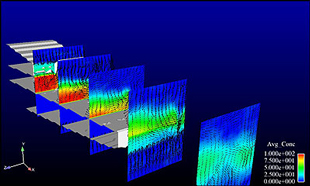Flow Diagnostics >>
National Aerospace Propulsion Conference (NAPC-2017)

Indian Institute of Technology Kanpur, March 15-17, 2017
The thermo-acoustic instabilities observed in liquid-fueled combustors involve the coupling of various multifaceted phenomena, such as spray atomization, vaporization, combustion, turbulence, chemistry, flow instabilities and acoustics. Due to their interaction, it is challenging to comprehend the isolated effect of each of these phenomena. It is thus essential to perform detailed experimental studies of the phenomenon, so as to expand the knowledge of the underlying physics in combustion instabilities and subsequently improve its modeling.
Tesscorn provides optical methods to measure flow velocity fields, size and velocity of droplets, and the location of combustion zones. Experimental tests are progressively linked with optical measurements, visualizations (high-speed video, OH* and CH* chemiluminescence) and laser-based optical techniques like LDV, PIV, PDI, and PLIF. Laser-based techniques are used depending on the quantities of interest and on the optical access. Particle Image Velocimetry (PIV) is one of the widely-used laser techniques in research institutes; major strength is its capacity to deliver a quantitative and instantaneous measurement of the velocity, not only at one point like Laser Doppler Velocimetry (LDV) does, but over a whole plane simultaneously for visualization and quantification of the 2D flow structure. Two or three components of the velocity can be obtained by using one or two cameras (stereoscopic PIV), respectively. Planar Laser-Induced Fluorescence (PLIF) imaging is species and quantum state specific, and is hence sensitive to species composition, temperature, number density and velocity. The OH radical is the most commonly used flame front indicator. Applied to this radical species, PLIF, like PIV, is able to provide instantaneous information over the whole plane of the flow field, without the line-of-sight averaging inherent to OH* chemiluminescence imaging. Simultaneous info on fuel and flame spatial distributions can be obtained with two PLIF laser systems probing OH and kerosene vapor concurrently. Furthermore, by seeding the flow with adequate fluorescing tracers or probing tracers naturally present in the flow, the mixture fraction distribution can also be obtained. PLIF applied to CO molecule can been applied to air-breathing engine flow investigation.
Three-component velocity fields can be captured using phase Doppler interferometry (PDI) and offers insight into fuel drop size and distribution, fuel injector spray angle and pattern, turbulence intensity, degree of vaporization and extent of reaction. In spray-fired systems, the need to discriminate between phases leads to considerable complication in delineating fuel–air mixing. Methods that focus on the discrete phase have successfully provided details relative to the droplets. PDI is ubiquitous in application to practical devices and under practical conditions.
